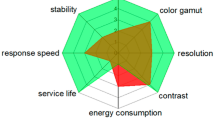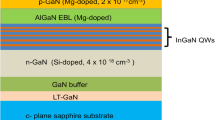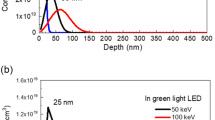Abstract
Ion-beam-assisted deposition (IBAD) was used for cathode preparation in organic light-emitting diodes to fabricate dense electrode. Dark spot growth rate was decreased by employing the IBAD process due to a highly packed aluminum structure inhibiting the permeation of H2O and O2. However, undesirable leakage current was generated because energetic particles of Al assisted by Ar+ ion may damage the organic material resulting in reduction of contact resistance. The decrease of contact resistance in the IBAD device may be caused by large contact area, increase of density of states, and Li diffusion to phenyl-substituted poly-p-phenylene vinylene.
Similar content being viewed by others
Change history
01 June 2006
This article has been retracted. Please see the Retraction Notice for more detail: https://doi.org/10.1557/jmr.2005.0004r
References
C.W. Tang and S.A. VanSlyke: Organic electroluminescent diodes. Appl. Phys. Lett. 51, 913 (1987).
J.H. Burroughes, D.D.C. Bradley, A.R. Brown, R.N. Marks, K. Mackay, R.H. Friend, P.L. Burn, and A.B. Holmes: Lightemitting diodes based on conjugated polymers. Nature 347, 539 (1990).
L.J. Rothberg and A.J. Lovinger: Status of and prospects for organic electroluminescence. J. Mater. Res. 11, 3174 (1996).
P.E. Burrows, V. Bulovic, S.R. Forrest, L.S. Sapochak, D.M. Mc- Carty, and M.E. Thompson: Reliability and degradation of organic light-emitting devices. Appl. Phys. Lett. 65, 2922 (1994).
V. Vimrova, S. Nespurek, R. Kuzel, and W. Schnabel: Electrodelimited photoinjection at metal/polymer interface. Synth. Met. 67, 103 (1994).
J. McElvain, H. Antoniadis, M.R. Hueschen, J.N. Miller, D.M. Roitman, J.R. Sheats, and R.L. Moon: Formation and growth of black spots in organic light-emitting diodes. J. Appl. Phys. 80, 6002 (1996).
L.M. Do, M. Oyamada, A. Koike, E.M. Han, N. Yamamoto, and M. Fujira: Morphological change in the degradation of Al electrode surfaces of electroluminescent devices by fluorescence microscopy and AFM. Thin Solid Films 273, 209 (1996).
V.N. Savvateev, A.V. Yakimov, D. Davidov, R.M. Pogreb, R. Neumann, and Y. Avny: Degradation of nonencapsulated polymer-based light-emitting diodes: Noise and morphology. Appl. Phys. Lett. 71, 3344 (1997).
L.S. Liao, L.S. Hung, W.C. Chan, X.M. Ding, T.K. Sham, I. Bellow, C.S. Lee, and S.T. Lee: Ion-beam-induced surface damages on tris-(8-hydroxyquinoline) aluminum. Appl. Phys. Lett. 75, 1619 (1999).
H. Suzuki and M. Hikita: Organic light-emitting diodes with radio frequency sputter-deposited electron injecting electrodes. Appl. Phys. Lett. 68, 2276 (1996).
G. Gu, V. Bulovic, P.E. Burrows, S.R. Forrest, and M.E. Thompson: Transparent organic light-emitting devices. Appl. Phys. Lett. 68, 2606 (1996).
L.S. Hung, L.S. Liao, C.S. Lee, and S.T. Lee: Sputter deposition of cathodes in organic light emitting diodes. J. Appl. Phys. 86, 4607 (1999).
I.D. Parker: Carrier tunneling and device characteristics in polymer light-emitting diodes. J. Appl. Phys. 75, 1656 (1994).
P.W.M. Blom, M.J.M. de Jong, and J.J.M. Vleggaar: Electron and hole transport in poly(p-phenylene vinylene) devices. Appl. Phys. Lett. 68, 3308 (1996).
A.J. Campbell, D.D.C. Bradley, and D.G. Lidzey: Space-charge limited conduction with traps in poly(phenylene vinylene) light emitting diodes. J. Appl. Phys. 82, 6326 (1997).
J. Shen and J. Yang: Physical mechanisms in double-carrier trapcharge limited transport processes in organic electroluminescent devices: A numerical study. J. Appl. Phys. 83, 7706 (1998).
H. Antoniadis, M.A. Abkowitz, and B.R. Hsieh: Carrier deeptrapping mobility-lifetime products in poly(p-phenylene vinylene). Appl. Phys. Lett. 65, 2030 (1994).
J.J. Cuomo, S.M. Rossnagel, and H.R. Kaufman: Handbook of Ion Beam Processing Technology-Principles, Deposition, Film Modification and Synthesis, (Noyes Publications, Park Ridge, NJ, 1989), p. 263.
B.M. Henry, F. Dinelli, K-Y. Zhao, C.R.M. Grovenor, O.V. Kolosov, G.A.D. Briggs, A.P. Roberts, R.S. Kumar, and R.P. Howson: A microstructural study of transparent metal oxide gas barrier films. Thin Solid Films 355, 500 (1999).
Y.G. Tropsha and N.G. Harvey: Activated rate theory treatment of oxygen and water transport through silicon oxide/poly(ethylene terephthalate) composite barrier structures. J. Phys. Chem. B. 101, 2259 (1997).
A.G. Erlat, R.J. Spontak, R.P. Clarke, T.C. Robinson, P.D. Haaland, Y. Tropsha, N.G. Harvey, and E.A. Vogler: SiOx gas barrier coatings on polymer substrates: Morphology and gas transport considerations. J. Phys. Chem. B 103, 6047 (1999).
A.S. da Silva Sobrinho, G. Czeremuszkin, M. Latreche, and M.R. Wertheimer: Defect-permeation correlation for ultrathin transparent barrier coatings on polymers. J. Vac. Sci. Technol. A 18, 149 (2000).
B.M. Henry, F. Dinelli, K-Y. Zhao, C.R.M. Grovenor, O.V. Kolosov, G.A.D. Briggs, A.P. Roberts, R.S. Kumar, and R.P. Howson: A microstructural study of transparent metal oxide gas barrier films. Thin Solid Films. 335–356.
A.P. Roberts, B.M. Henry, A.P. Sutton, C.R.M. Grovenor, G.A.D. Briggs, T. Miyamoto, M. Kano, Y. Tsukahara, and M. Yanaka: Gas permeation in silicon-oxide/polymer (SiOx/PET) barrier films: Role of the oxide lattice, nano-defects and macrodefects. J. Membr. Sci. 208, 75 (2002).
J.S. Kwak, H.K. Baik, J.H. Kim, and S.M. Lee: Suppression of silicide formation in Ta/Si system by ion-beam-assisted deposition. Appl. Phys. Lett. 71, 2451 (1997).
P.E. Burrows and S.R. Forrest: Electroluminescence from traplimited current transport in vacuum-deposited organic lightemitting devices. Appl. Phys. Lett. 64, 2285 (1994).
P.E. Burrows, Z. Shen, V. Bulovic, D.M. McCarty, and S.R. Forrest: Relationship between electroluminescence and current transport in organic heterojunction light-emitting devices. J. Appl. Phys. 79, 7991 (1996).
M. Meier, S. Karg, and W. Riess: Light-emitting diodes based on poly-p-phenylene-vinylene: II. Impedance spectroscopy. J. Appl. Phys. 82, 1961 (1997).
H. Aziz and G. Xu: Electric-field-induced degradation of poly(pphenylenevinylene) electroluminescent devices. J. Phys. Chem. 101, 4009 (1997).
G. Parthasarathy, P.E. Burrows, V. Khalfin, V.G. Kozlov, and S.R. Forrest: A metal-free cathode for organic semiconductor devices. Appl. Phys. Lett. 72, 2138 (1998).
V. Bulovic, P. Tian, P.E. Burrows, M.R. Gokhale, and S.R. Forrest: A surface-emitting vacuum-deposited organic light emitting device. Appl. Phys. Lett. 70, 2954 (1997).
S.R. Forrest, L.Y. Leu, F.F. So, and W.Y. Yoon: Optical and electrical properties of isotype crystalline molecular organic heterojunctions. J. Appl. Phys. 66, 5908 (1989).
A. Rajagopal, C.I. Wu, and A. Kahn: Energy level offset at organic semiconductor heterojunctions. J. Appl. Phys. 83, 2649 (1998).
G. Parthasarathy, C. Adachi, P.E. Burrows, and S.R. Forrest: High-efficiency transparent organic light-emitting devices. Appl. Phys. Lett. 76, 2128 (2000).
E.I. Haskal, A. Curioni, P.F. Seidler, and W. Andreoni: Transparent organic light-emitting devices. Appl. Phys. Lett. 68, 2606 (1997).
J. Kido and T. Matsumoto: Bright organic electroluminescent devices having a metal-doped electron-injecting layer. Appl. Phys. Lett. 73, 2866 (1998).
Author information
Authors and Affiliations
About this article
Cite this article
Jeong, S.M., Koo, W.H., Choi, S.H. et al. RETRACTED ARTICLE: Influence of electrode modification by Ar+ ion beam upon passivation and electrical characteristics in organic light-emitting diodes. Journal of Materials Research 20, 81–92 (2005). https://doi.org/10.1557/JMR.2005.0004
Received:
Accepted:
Published:
Issue Date:
DOI: https://doi.org/10.1557/JMR.2005.0004




